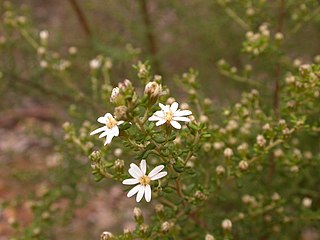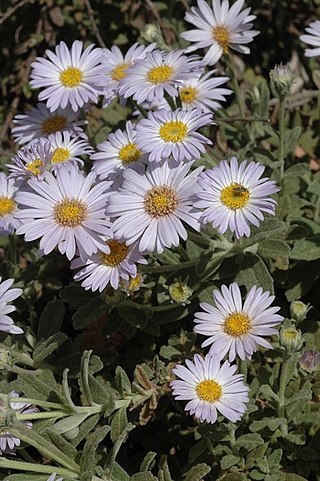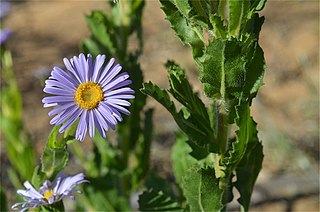
Olearia axillaris, commonly known as coastal daisy-bush, coast daisy-bush or coastal daisybush is a species of flowering plant in the family Asteraceae and is endemic to coastal areas of Australia. It is an erect, bushy shrub with densely cottony-hairy branchlets, aromatic, linear to narrowly elliptic or narrowly lance-shaped to egg-shaped leaves with the narrower end towards the base and small white and yellow, daisy-like inflorescences.

Olearia ramulosa, commonly known as twiggy daisy-bush, is a species of flowering plant in the family Asteraceae and is endemic to south-eastern Australia. It is a shrub with narrowly elliptic, linear or narrowly egg-shaped leaves, and pale blue, mauve or white and yellow, daisy-like inflorescences.

Olearia microphylla, commonly known as snow bush, small-leaved daisy-bush or twiggy daisy-bush, is a species of flowering plant in the family Asteraceae and is endemic to eastern Australia. It is a shrub with spatula-shaped leaves with the edges rolled under, and white and yellow, daisy-like inflorescences.

Olearia glutinosa, commonly known as sticky daisy-bush, is a species of flowering plant in the family Asteraceae and is endemic to south-eastern Australia. It is an erect, bushy, glabrous shrub with linear leaves and mauve, pink or white and yellow, daisy-like inflorescences.

Olearia myrsinoides, commonly known as silky daisy-bush or blush daisy bush, is a species of flowering plant in the family Asteraceae and is endemic to south-eastern Australia. It is a spreading shrub with hairy branchlets, egg-shaped to elliptic leaves with toothed edges, and white and yellow or mauve, daisy-like inflorescences.

Olearia decurrens, commonly known as the clammy daisy bush, is a species of flowering plant in the family Asteraceae and is endemic to arid, inland Australia. It is a glabrous, sticky, twiggy shrub with narrow egg-shaped to linear leaves sometimes with toothed edges, and white and yellow, daisy-like inflorescences.

Olearia iodochroa, commonly known as the violet daisy bush, is a species of flowering plant in the family Asteraceae and is endemic to south-eastern continental Australia. It is a shrub with branchlets densely covered with whitish hairs, narrowly egg-shaped leaves with the narrower end towards the base, and white or mauve, and cream-coloured, yellow or blue, daisy-like inflorescences.

Olearia brevipedunculata, commonly known as the dusty daisy-bush, is a small shrub with whitish-grey foliage and white daisy-like flowers in summer. Mostly found in Victoria and scattered locations in New South Wales, Australia.

Olearia muelleri, commonly known as Mueller daisy bush, Mueller's daisy bush or Goldfields daisy, is a species of flowering plant in the family Asteraceae and is endemic to southern continental Australia. It is a compact or spreading shrub with scattered spatula-shaped to egg-shaped leaves with the narrower end towards the base, and white and yellow, daisy-like inflorescences.

Olearia calcarea, commonly known as limestone daisy bush, is a species of flowering plant in the family Asteraceae and is endemic to southern continental Australia. It is a shrub with egg-shaped or broadly spoon-shaped leaves with toothed edges, and white and yellow, daisy-like inflorescences.
Olearia curticoma is a species of flowering plant in the family Asteraceae and is endemic to Victoria. It is an erect shrub with glabrous, sticky branchlets, linear leaves and white and yellow, daisy-like inflorescences.

Olearia frostii, commonly known as Bogong daisy-bush, is a species of flowering plant in the family Asteraceae and is endemic to Victoria in Australia. It is a low, often straggling shrub with egg-shaped leaves with the narrower end towards the base, and mauve to pink and yellow, daisy-like inflorescences.
Olearia incana is a species of flowering plant in the family Asteraceae and is endemic to southern Australia. It is a shrub with narrowly elliptic or wedge-shaped leaves and white and pale yellow, daisy-like inflorescences.

Olearia lanuginosa is a species of flowering plant in the family Asteraceae and is endemic to southern Australia. It is an erect shrub with egg-shaped leaves and white to mauve and yellowish, daisy-like inflorescences.

Olearia lepidophylla, commonly known as club-moss daisy-bush, is a species of flowering plant in the family Asteraceae and is endemic to southern Australia. It is a rigid, erect to spreading shrub with tiny oblong to egg-shaped leaves and white and yellow, daisy-like inflorescences.

Olearia passerinoides, commonly known as slender daisy bush, is a species of flowering plant in the family Asteraceae and is endemic to southern continental Australia. It is a slender, sticky shrub with linear leaves, and white or pale mauve and mauve or pink daisy flowers.
Olearia picridifolia, commonly known as rasp scrub-daisy, is a species of flowering plant in the family Asteraceae and is endemic to southern continental Australia. It is a low, spreading shrub with narrowly egg-shaped or narrowly elliptic leaves, and blue, mauve or white and yellow, daisy-like inflorescences.

Olearia rudis, commonly known as azure daisy-bush, is a species of flowering plant in the family Asteraceae and is endemic to eastern Australia. It is a usually short-lived shrub with crowded elliptic or egg-shaped leaves, and pale blue, mauve or purple and orange, daisy-like inflorescences.

Olearia stenophylla is a species of flowering plant in the family Asteraceae and is endemic to New South Wales. It is a shrub with oblong to linear leaves, and white and yellow, daisy-like inflorescences.

Olearia subspicata, commonly known as spiked daisy bush or shrubby daisy-bush, is a species of flowering plant in the family Asteraceae and is endemic to continental Australia. It is an erect shrub with more or less linear leaves and white and yellow, daisy-like inflorescences.



















